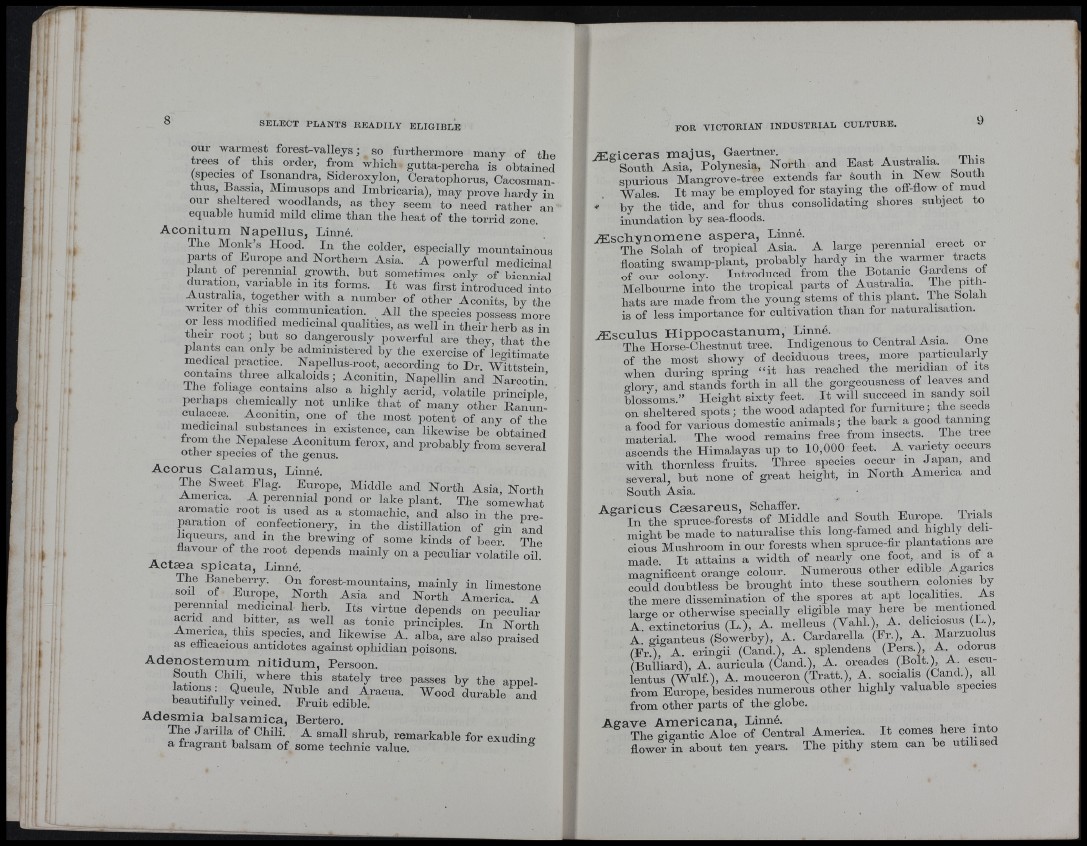
our warmest forest-valleys; so furthermore many of the
trees _ of this order, from which gutta-percha is obtained
(species of Isonandra, Sideroxylon, Ceratophorus, Cacosman-
thus, Bassia, Mimusops and Imbricaria), may prove hardv in
our sheltered woodlands, as they seem to need rather an
equable humid mild clime than the heat of the torrid zone.
Aconitum Napellus, Linné.
The Moiffi’s Hood In the colder, especially mountainous
parts of Europe and Northern Asia. A powerful medicinal
plant _ of perennial growth, but sometimes only of biennial
duration, variable in its forms. I t was first introduced into
Australia, together with a number of other Aconits bv the
writer of this communication. All the species possess more
or less modified medicinal qualities, as well in their herb as in
their ro o t; but so dangerously powerful are they, that the
plants can only be administered by the exercise of legitimate
medical practice. Napellus-root, according to Dr. w lttstein
contains three alkaloids; Aconitin, Napellin and Narcotin’
Ih e foliage contains also a highly acrid, volatile principle'
perhaps chemically not unlike th a t of many other Eanun-
cnlaceæ. Aconitin, one of the most potent of any of the
medicinal substances in existence, can likewise be obtained
from the Nepalese Aconitum ferox, and probably from several
otlier species of the genus.
Acorus Calamus, Linné.
The Sweet Flag. Europe, Middle and North Asia, North
America. A perennial pond or lake plant. The somewhat
aiomatic root is used as a stomachic, and also in the preparation
of confectionery, in the distillation of mn L d
bqueurs, and in the brewing of some kinds of beer The
flavour of the root depends mainly on a peculiar volatile oil.
Actaea spicata, Linné.
The Baneberry. On forest-mountains, mainly in limestone
soil of Europe, North Asia and North America. A
perennial medicinal herb. Its virtue depends on peculiar
acrid and bitter, as well as tonic principles. In North
Ammca,_ this species, and_ likewise A. alba, are also praised
as emcacious antidotes against ophidian poisons.
Ad6nost6muni nitidurn, Persoon.
South Chili, where this stately tree passes by the appel-
^ Aracua. Wood durable and
beautifully veined. Em it edible.
Adesmia balsamica, Bertero.
The Jarilla of Chili A small shrub, remarkable for exudin«-
a fragrant balsam of some technic value. ^
and E a rt Australia.
spurious Mangrove-tree extends far south m New South
Wales. I t may be employed for staying the off-flow- of mu
^ by the tide, and for thus consolidating shores subject to
inundation by sea-floods.
Æ sd iv n om en e aspera, Linné.
The Solali of tropical Asia. A large perennial erect oi
floating swamp-plant, probably liardy in the warmer tracts
of our colony. Introduced from the Botanic Gardens of
Melbourne into the tropical parts of Australia The pit i-
hats are made from the young stems of this plant. The boiah
is of less importance for cultivation than for naturalisation.
to Central Asia. One
of the most showy of deciduous trees, more particulaijy
when during spring “ it lias reached the meridian of its
alory, and stands forth in all the gorgeonsness of leaves and
blossoms.” Height sixty feet. I t will succeed in sandy soil
on sheltered spots; the wood adapted for furniture; the seeds
a food for various domestic animals ; the bark a good tanning
material The wood remains free from insects. Hie tree
ascends the Himalayas up to 10,000 feet. A variety occurs
with thornless fruits. Three species occur in Japan, and
several, but none of great height, in North America and
South Asia.
A ffa ric u s C æ s a r e u s , Schaffer. ^ , -r. m • i
In the spruce-forests of Middle and South Europe. Trials
mi"ht be made to naturalise this long-famed and biglily delicious
Mushroom in our forests when spruce-fir plantations are
made. I t attains a width of nearly one foot, and is ot a
magnificent orange colour. Numerous other edible Agarics
could doubtless be brought into these southern colonies by
the mere dissemination of the spores at apt localities A s
large or otherwise specially eligible may here be mentioned
A . extinctorius (L.), A. melleus (Vahl.) A deliciosus (L.),
A. giganteus (Sowerby), A. Cardarella (FrJ, A. Marznolus
(ErO, A. eringii (Cand.), A. splendens
(Bulliard), A. auricula (Cand.), A. oreades (Bolt ), A. escn-
lentus (Wulf.), A. mouceron (Tratt.), A. socialis (Cand.), all
from Europe, besides numerous other highly valuable species
from other parts of the globe.
Agave Americana, Linné.
The giffantio Aloe of Central America. I t c o m e s here into
flower in about ten years. The pithy stem can be utilised